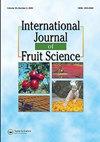Nutritional Value of Underutilized Fruit: Diospyros chloroxylon Roxb. (Green Ebony Persimmon)
IF 2.4
3区 农林科学
Q2 HORTICULTURE
引用次数: 3
Abstract
ABSTRACT Diospyros chloroxylon is the indigenous fruit of the Indian subcontinent and both unripe and ripe fruits are eaten by tribal people. The present study explores the nutritional status of Diospyros chloroxylon fruits. Unripe and ripe fruits were rich in fat, protein, carbohydrate, ash, fiber, and minerals. The energy levels of unripe, ripe fruits, and seeds were 93.78, 133.93, and 96.16 Kcal/100 g, respectively. Ripe fruits were also rich in phenolics (4.64 mg GAE/g DW) and flavonoids (1.62 mg QE/ g DW). Acetone, methanol, and water extracts of unripe, ripe fruits and seeds displayed potent free radical scavenging properties. The seeds of D. chloroxylon possess 3.16% oil and it contains oleic acid (39.91%) and palmitic acid (28.06%) as major fatty acids.未充分利用果实的营养价值:绿梭梭。(绿乌木柿子)
摘要氯氧锡兰是印度次大陆的原生水果,其成熟和未成熟的果实都是印度部落居民的食物。本研究探讨了氯氧梭果实的营养状况。未成熟和成熟的水果都富含脂肪、蛋白质、碳水化合物、灰分、纤维和矿物质。未成熟果实、成熟果实和种子的能量水平分别为93.78、133.93和96.16 Kcal/100 g。成熟果实还富含酚类物质(4.64 mg GAE/g DW)和类黄酮(1.62 mg QE/ g DW)。丙酮、甲醇和水提取物的未成熟,成熟的水果和种子显示出有效的自由基清除性能。绿梭梭种子含油量为3.16%,主要脂肪酸为油酸(39.91%)和棕榈酸(28.06%)。
本文章由计算机程序翻译,如有差异,请以英文原文为准。
求助全文
约1分钟内获得全文
求助全文
来源期刊

International Journal of Fruit Science
Agricultural and Biological Sciences-Agronomy and Crop Science
CiteScore
6.40
自引率
0.00%
发文量
64
审稿时长
10 weeks
期刊介绍:
The International Journal of Fruit Science disseminates results of current research that are immediately applicable to the grower, extension agent, and educator in a useful, legitimate, and scientific format. The focus of the journal is on new technologies and innovative approaches to the management and marketing of all types of fruits. It provides practical and fundamental information necessary for the superior growth and quality of fruit crops.
This journal examines fruit growing from a wide range of aspects, including:
-genetics and breeding
-pruning and training
-entomology, plant pathology, and weed science
-physiology and cultural practices
-marketing and economics
-fruit production, harvesting, and postharvest
 求助内容:
求助内容: 应助结果提醒方式:
应助结果提醒方式:


